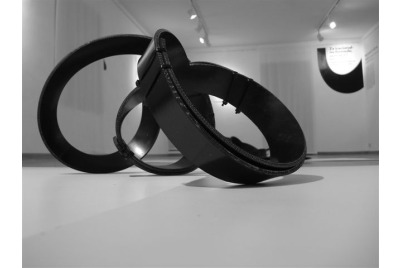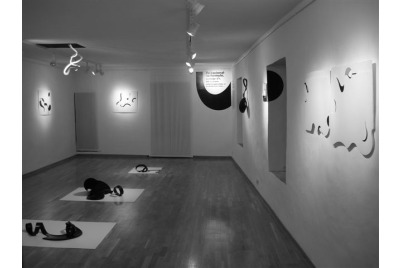

Изложба обекти от гума, хартия и видео на Саша Панчич – Сърбия
Изложба „Бъдещето е зад нас” / Култура на свободата
Обекти от гума, хартия и видео
Аторът е почерпил вдъхновение от идеята в романа на Евгени Замятин „Ние”, написан през 1920г. , публикуван е за първи път в Америка през 1924 г. , през 1927 г. е издаден на руски език в Прага и едва през 1988 г. - за първи път в Русия.
“THE FUTURE IS BEHIND US”
A culture of freedom
Russian avant-garde uses an anti-futuristic slogan:”The future is behind us” (Larionov-Goncharova) to invalidate the concept of progress, modern dynamism and the ideology of the New. This eastern heresy, occurring amidst European Futuristic verve, was a Copernican turn and a potent contribution to the modern art theory and practice. Conversely, “the Russian experiment” was giving a vigorous performance in the act of inauguration of the new world order, forsaking all prospects to critically review events and consequences upon its immediate environment. Such an absurd position was a fertile ground for the emergence of invaluable artists like Bulgakov and Zamyatin, whose art “saw further”, right up to the present day.
In 1920, Yevgeny Zamyatin writes a novel entitled “We”, where he indulges in a deep irony regarding the system of a controlled society. Playfully, and without malice or enmity, he exposes the many absurdities of the Soviet Communist system. Revolutionary upheaval wreaks havoc, rushing towards installing a magnificent new order that will scale cosmic heights. Yawning whirlpool of the Revolution found Yevgeny Zamyatin swimming upstream and using humor to defend and maintain a sound mind.
“Here I learned from personal experience that laughter is the most terrible of weapons; you can kill anything with laughter – even murder”.
Four years after it’s been written, Zamyatin’s manuscript found its way to America where it was first published in 1924. In 1927, a summary of the novel was published in Russian language in Prague, and only in 1988 for the first time in Russia.
As if nothing had changed, we came full circle, only to find ourselves at the same starting point. Now, reflecting in the Zamyatin’s mirror, we are faceless and impersonal, with a different name and without ideological frames, under the umbrella of mass media and mass production. The slogan “The future is behind us” points in Zamyatin’s direction, giving him a contemporary context and rendering him the wittiest prophet of the modern society.
Saša Pančić





